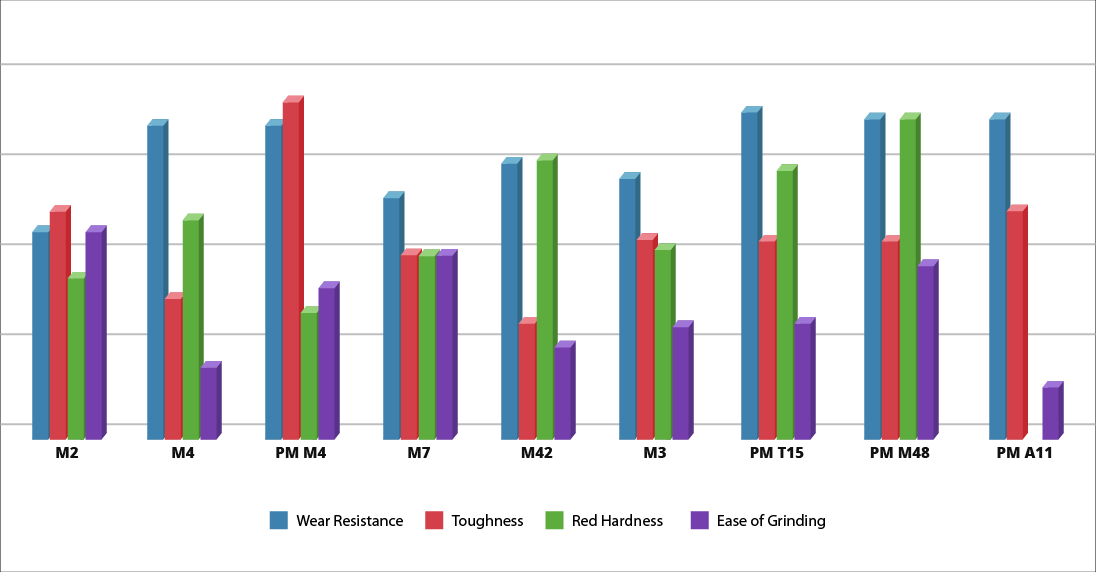Griggs Steel no longer carries this product but has PM T15.
A Cobalt high-alloyed powder metallurgy high-speed steel corresponding to PM 30 + Co. The high-compressive strength and exceptional abrasive wear-resistance makes PM 30 high-speed steel suitable for demanding cold work applications and for cutting tools as an alternative to AISI M42 or other Co-alloyed high-speed steels. The PM process gives this steel excellent machinability, as well as a good dimension stability during heat treatment. We are also constantly impressed with PM 30’s temper-resistance and through-hardening properties.
Other Known Names: ASP 2030, CPM REX 45®, SKH 56, M36, S590, HS 6-5-3-8
Griggs Steel Color Code:Brown
Broaches, Drills, End Mills, Hops, Taps
Density
0.287 lb/in3 (8256 kg/m3)
Modulus Of Elasticity
34 x 106 psi (240 GPa)

| Maximum | Typical | ||||||
|---|---|---|---|---|---|---|---|
| Carbon | Chromium | Tungsten | Molybdenum | Vanadium | Cobalt | Annealed | Tempered |
| C | Cr | W | Mo | V | Co | Hb | HrC |
| 1.25 | 4.2 | 6.4 | 5 | 3.1 | 8.5 | 260 | 65 |
| Annealing | Preheat | Austenitizing | Quench | Tempering |
|---|---|---|---|---|
| Temp | Temp | Temp | Medium | Temp |
| °F | °F | °F | °F | |
| 1575/1625 | 1500/1550 | 2125/2175 | Salt/Oil/Atm | 1040 |
Heat rapidly from the preheat, typically by transferring to a second furnace.
1920-2160°F (1050-1180°C) according to the desired final hardness.
The tool should be protected against decarburization and oxidation during hardening.
Vacuum furnace with high speed gas at sufficient overpressure (2–5 bar).
Martempering bath or fluidized bed at approx. 1004°F (540°C).
Quenching should be continued until the temperature of the tool reaches approx. 120°F (50°C). The tool should then be tempered immediately.
In order to obtain a high toughness, the cooling speed in the core should be at least 20°F/sec. (10°C/sec.). This is valid for cooling from the austenitizing temperature down to approx. 1004°F (540°C). After temperature equalization between the surface and core, the cooling rate of approx. 10°F/sec. (5°C/sec.) can be used. The above cooling cycle results in less distortion and residual stresses.
Temper immediately after quenching.
For cold work applications tempering should always be carried out at 1040°F (560°C) irrespective of the austenitizing temperature. Temper three times for one hour at full temperature. The tool should be cooled to room temperature between the tempers. The retained austenite content will be less than 1% after this tempering cycle.
Annealing must be performed after hot working and before re-hardening.
Heat at a rate not exceeding 400°F per hour (222°C per hour) to 1600°F (871°C), and hold at temperature for 1 hour per inch (25.4 mm) of thickness, 2 hours minimum. Then cool slowly with the furnace at a rate not exceeding 30°F per hour (17°C per hour) to 1000°F (538°C). Continue cooling to ambient temperature in the furnace or in air.